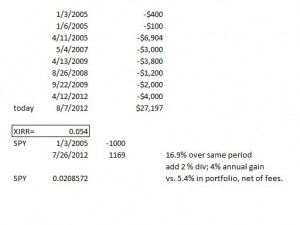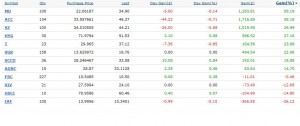I don’t do individual stock reviews and such these days since I’ve taken more of a passive/low-fee approach over the years compared to active stock-picking (hence my other site ETF Base which is focused solely on ETF investing and strategies). Anyway, what I set out to do years ago was to pick a basket of high yielding stocks for my self-directed Roth IRA account and keep reinvesting the dividends in the same account in a tax-free manner. As it turns out, the account has beaten the return of the S&P500 over the past 7 years and I have the detailed evidence to back it up. When someone beats an index over a prior month period or even a prior year period because they picked Apple stock or whatever, that’s not much of an achievement and can often be attributed purely to luck (random variability actually; I don’t believe in good or bad luck). But with the approach I took with high yielders in various sectors, it appears to have won out over a slow moving US market this decade.
Roth IRA Benefits
The beauty of the Roth IRA or any other IRA (details about it can be found here) is that dividends and capital gains aren’t taxed. See, any funds you invest in a Roth are from post-tax dollars you’ve already earned, so dividends and capital gains go untaxed for the life of the account, as long as you wait until 59 1/2 before withdrawing funds. Granted, there are income limits to contribute which are the following:
The Roth IRA MAGI (modified adjusted gross income) phase out ranges for 2012 are:
- Single filers: Up to $110,000 (to qualify for a full contribution); $110,000–$125,000 (to be eligible for a partial contribution)
- Joint filers: Up to $173,000 (to qualify for a full contribution); $173,000–$183,000 (to be eligible for a partial contribution)
So, anyone under those limits can contribute up to $5,000 each or $10,000 per couple. It’s not as much as you can sock away in a 401(k), but I like funds in this account over a 401(K) anyway since 401(k) plans tend to have higher expense ratios, are likely to see a higher tax rate in retirement and many other reasons I outlined in this article on Roth IRAs over 401(k)s.
Under the Hood of My Roth IRA
As I mentioned, over the years, I’ve chosen stocks from various sectors, often yielding about 6-9%, with the assumption that even if they don’t have much capital appreciation, the dividends alone will roughly match the market and the few that have capital appreciation will push it the total return over the edge. That appears to be what happened. In order to keep fees in check, I only buy into a new position when I have over $1000 in cash, so the trading fee is always less than 1% of the amount purchased. Â And I don’t sell (or trade). Â I’ve only sold 1 position in the 7 years as I recall. Anyway, in order of % gain (to the right), here are the positions which don’t include dividend returns:
(click to enlarge)
- MO (Altria) is my strongest performer (I also own VG Vector group below). While I’m not a fan of tobacco products in general, as an investment, it’s well-known that they are often a great investment. High cash flow, high dividends, and many settlements have already been reached, which makes catastrophic litigation unlikely.
- ACC is the college real estate ETF. I love this one since I got into college real estate investing myself. What a concept! Immune to the housing crisis at large, students are always going to need housing. It’s been a stellar performer.
- HYG – I bought this high yield bond fund during the financial crisis and it’s given my 8-10% yields annually not to mention some capital gains.
- T, VZ – both AT&T and Verizon have nice yields and since the launch of the iPhone, they’ve been doing well with a new source of income for the data plans nobody can live without.
- AGNC is throwing off a fat 15% yield which would usually raise a red flag as a diving stock with an artificially high yield, but this one’s only been moving up, not down, indicating the market is not pricing in a cut.
The rest of done so-so when you consider the 6-8% dividends over the years – roughly a wash even on the ones in the red.
Returns Calculated
The thing is, it’s tough to do an apples to apples comparison when you’re making annual investments and trying to compare to a fixed equity index. So, what I did was used the Internal Rate of Return (simple Excel function fully explained in that post) to show what my annualized return was given the periodic investments I made.

The calculation showed that I returned 5.4% annually net of trading expenses.
When I go back to the inception of the account, the S&P500 (SPY ETF) returned 16% over the same period which breaks down to 2% annualized. If you consider that SPY pays a dividend hovering around 2% over the years, then let’s just call it a 4% annualized return.
So, over a 7+ year period, I beat the market by about 1.4% net of all fees.
Not too shabby. Virtually no professional money managers to that – ever. They tend to lose money to the market and collect 7 figure salaries doing so. Over this time period, hedge funds have done very poorly as well while collecting 2 and 20. So, I thought it was worth sharing.
While a 1.4% beat may not seem like much, since we’re all long-term investors here, let’s take a 20 years time horizon for say, a pension rollover. Â If I had rolled over $100,000 and earned 4% vs. 5.4% a year, at the end of 20 years, it would be worth $219K vs. $286K, a difference of $67,000! Â That’s a pretty big difference for such a small increase in returns, but that’s the difference between meeting the market and beating the market. Â Of course, those are future dollars and in present value, let’s say it’s only say, $35,000. Â It’s still significant and depending on how much you invest over a lifetime, or how much you exceed market returns by, the difference could be huge.
If you’re interested in high yield investing, there are numerous options out there besides dividend stocks, including Preferred Stocks and High Yield Master Limited Partnerships.
$600 to Open a Roth IRA!
As it turns out, if you don’t have your own Roth IRA now and want some additional funds to start it up, you can get up to $600 depending on how much you roll over or fund the account with via this promo from OptionsHouse.  If you are just starting out with a $5,000 new account or smaller, the best deal is 100 Free Trades.  You won’t even need them, but it’s worth it!  No other online brokerage is offering anything like it and their $3.95 stock trades are as low as it gets in the industry.  For the purposes of a trade or two a year using the method I outlined, it’s a great deal.  Check out the signing bonus deal here or the 100 Free Trades here.


{ 15 comments… read them below or add one }
You might consider PM as well or in place of MO. Smoking inside the US is on a long term downward trend while smoking overseas is still growing.
I had compared them back in the day and PM’s dividend was too low; about 1% lower than MO’s. I had figured that was priced in and following the settlements in the US, I keep seeing more taxes slapped on and they just keep increasing prices to maintain their margins. It seems to be working! The stock is doing pretty well and divvy is firm.
Good post and you’ve done an excellent job.
Maybe we define terms differently. To me a money manager is the person(s) running the mutual fund, the ETF, the separate account, etc. In many cases you are right, they don’t always beat their benchmark, hence a good case for low cost indexing. I think perhaps you were referring to financial planners/financial advisors. Here, hopefully, they’ve established a benchmark which is a blend based on the client’s target allocation. Ideally the portfolio will beat that benchmark, but even if it keeps pace with the benchmark that is a good thing assuming the client’s allocation is tied to an overall financial plan.
Sure, like a mutual fund manager. Most actively managed mutual funds can’t beat the index they’re benchmarked against, often provide no better risk-adjusted return, incur higher tax liabilities due to trades, and then collect a hefty expense ratio for the insult.
Good job! Remember, no stock goes ups all the time. It may be a consistent performer, but it won’t always go up.
Hence the high dividend yield strategy; I actually don’t mind a roughly flat market when my investments are yielding 6-9%.
Congrats on beating the market! I hope you can continue to do so over the long term. I personally don’t think I can so I just invest in mutual funds that track the markets.
Focusing on fees and the right asset classes over individual stock-picking is definitely a winning strategy compared to what most investors do.
Forgive me plugging my S&P Return Calculator, but I wanted to compliment you on your estimating skills, haha. I put in January 2005 until July 2012 and got 1.891% and 3.968% with dividends reinvested.
ACC – that’s an interesting ETF. Checking out the details on that guy.
Glad to hear my “back of the napkin” estimate met the grade! I do like ACC – not so much for current yield, but for increasing dividend payouts and capital appreciation. It’s a nice one!
PK, if you are going to look into ACC let me know how they pay a div of $1.35 per share with earnings of $0.66
Well, in general you don’t usually want to see that. However, note that preferred share dividends are paid out before EPS is even calculated, so on stocks that show weird rations it might be factored in already. Additionally, dividends are paid from deferred earnings (booked from previous quarters).
I didn’t end up buying ACC, fwiw.
Not too shabby indeed. Now the question I have to ask is whether your real property beat out your real estate stock??
Congrats on beating the market over 7 years.
Remember the number 1 rule of investing: past returns are not guarantees of future returns.
How long until you start your own Yacktman Fund? I think he holds onto stocks an average of 50 years ( super low turnover). When you do, I’ll toss some money your way.
{ 4 trackbacks }